2022 XC90 Volvo Exterior lighting

Active bending lights
(Option/accessory)
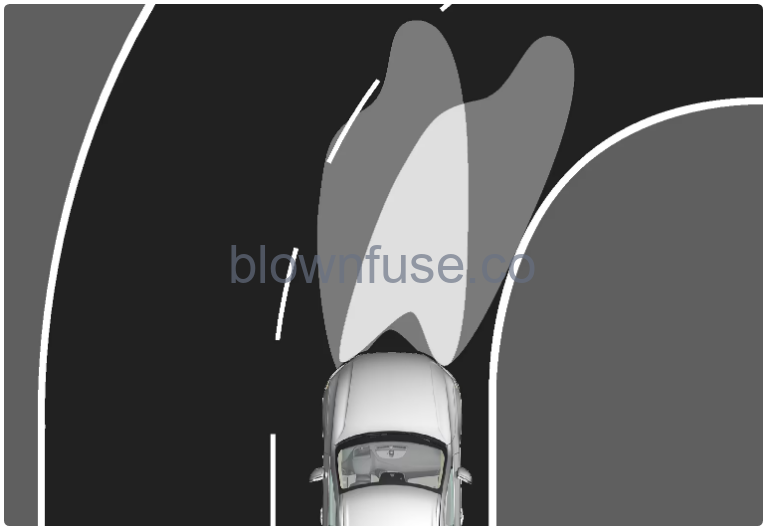
Headlamp pattern with function deactivated (left) and activated (right) respectively. Active bending lights follow steering wheel movements to provide additional illumination in bends and junctions and can thereby provide the driver with improved visibility. The function is activated automatically when the car is started. In the event of a fault in the function, the symbol illuminates in the driver display at the same time as the driver display shows an explanatory text. The active bending lights are only switched on in weak daylight or in darkness as well as when the stalk switch’s rotating ring is in the AUTO position. The car also needs to be in motion with a dipped beam activated.
Deactivating/activating the function
The function is activated when the car is supplied from the factory and can be deactivated/activated via the center display’s function view.

Press the Active Bending Lights button.
Active main beam
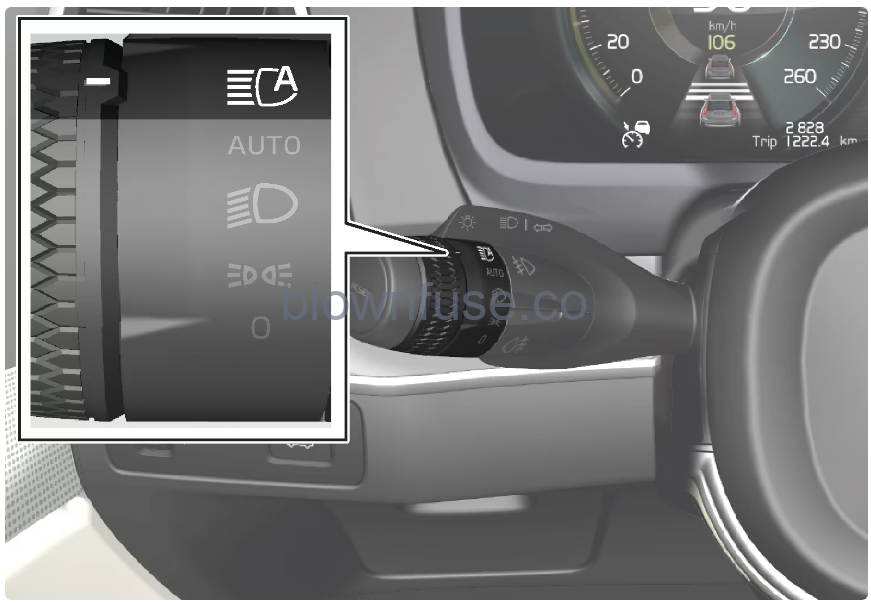
The symbol represents the active main beam. The function can start while driving in the dark when the car’s speed is approx. 20 km/h (approx. 12 mph) or higher. The function can also take streetlights into account. When the camera sensor no longer detects any oncoming car or car in front, main beam is switched on again after about a second.
Activate active main beam
The active main beam is activated and deactivated by turning the left-hand stalk switch to position. The rotating ring then returns to position AUTO. When the active main beam is activated, the symbol illuminates with a white glow in the driver display. When main beam is activated, the symbol shines blue.
If the active main beam is deactivated while the main beam is on, the lighting is immediately reset to the dipped beam.
The active main beam does not need to be reactivated every time the car is started.
Adaptive functionality
For cars with LED headlamps, the active main beam has adaptive functionality. In this case, unlike what happens during conventional dimming, the light beam continues to illuminate with main beam on both sides of oncoming traffic or vehicles ahead – only the part of the light beam that points directly to the vehicle is dimmed.
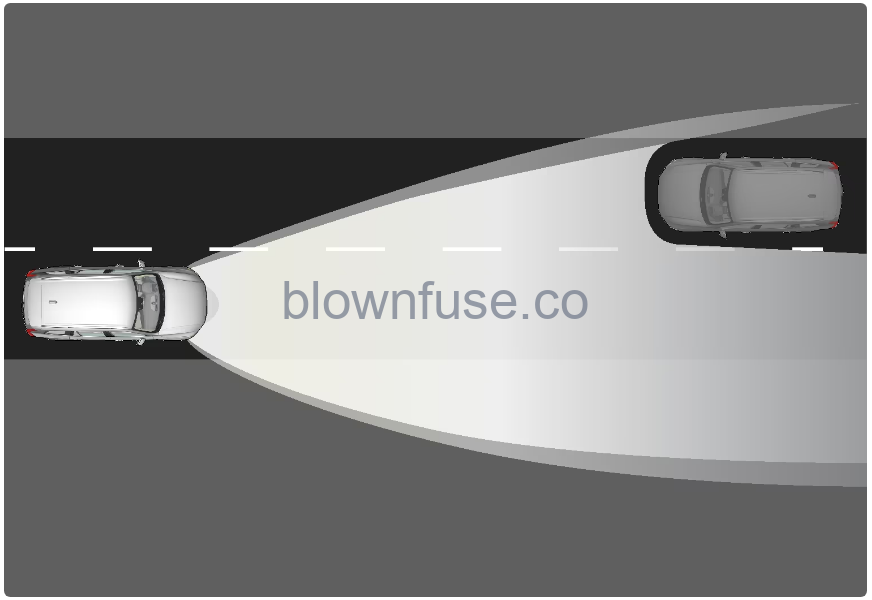
Adaptive functionality: Dipped beam directly towards the oncoming vehicle, but continued the main beam on both sides of the vehicle.
The main beam is partly dimmed, i.e. if the light beam shines slightly more than the dipped beam, the symbol in the driver display shines blue.
On motorways or at high speed, the system may change from adaptive to automatic functionality.
Limitations for active main beam
The camera sensor on which the function is based has limitations.

If this symbol is shown in the driver display, together with the message Active High Beam Temporarily unavailable, then switching between the main and dipped beam must be performed manually.

The same applies if this symbol is shown together with the message Windscreen sensor Sensor blocked, see Owner’s manual.
The active main beam may be temporarily unavailable e.g. in situations with dense fog or heavy rain. When the active main beam becomes available again, or the windscreen sensors are no longer blocked, the message is extinguished and the active main beam is reactivated.
Active main beam is an aid for using the optimum beam pattern when conditions are favorable.The driver always bears responsibility for manually switching between the main and dipped beam when traffic situations or weather conditions so require it.
Using direction indicators
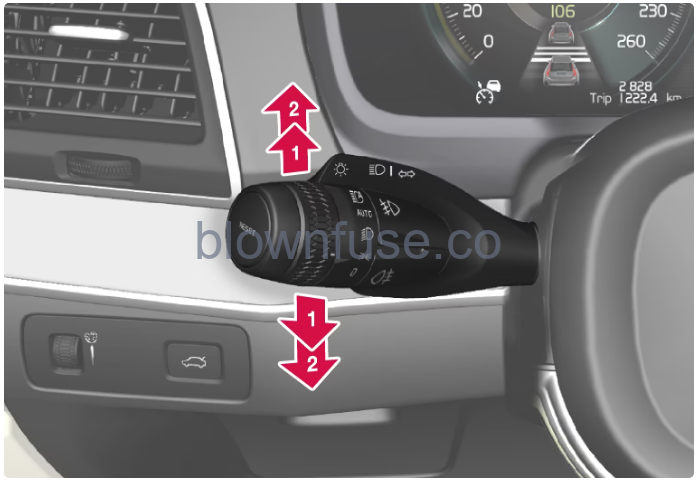
Direction indicators.
Short flash sequence
| Move the stalk switch up or down to the first position and release. The direction indicator lamps flash three times. If the function is deactivated via the centre display, the lamps will flash once. |
Note
- This automatic flashing sequence can be stopped by moving the stalk switch immediately in the opposite direction.
- If the symbol for direction indicators in the driver display flashes more quickly than normal – see the message in the driver display.
Continuous flash sequence
| Move the stalk switch up or down to its end position. |
The stalk switch remains in its position and is moved back manually, or automatically by the steering wheel movement.
Brake lights
Rear fog lamp
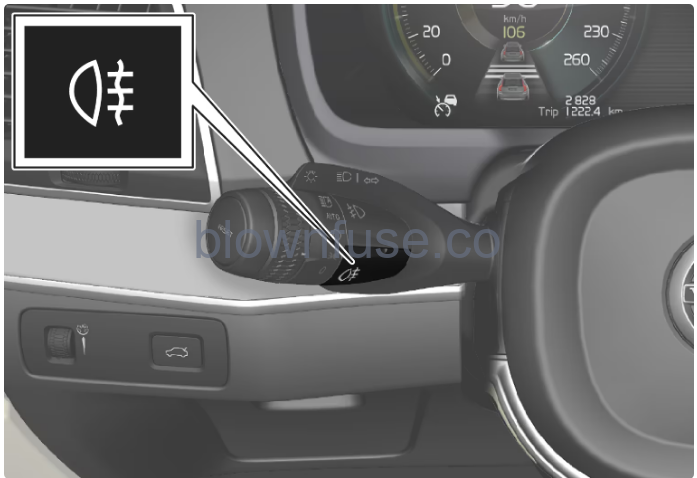
Button for rear fog lamp.
The rear fog lamp is a lamp at the rear of the car, on the driver’s side.
The rear fog lamp can only be switched on when:
- ignition position II is active and the rotating ring on the stalk switch is in position AUTO or

- the stalk switch’s rotating ring is in position
 and the front fog lamps are switched on.
and the front fog lamps are switched on.
Press the button to switch the lights on/off. The ![]() symbol in the driver display illuminates when the rear fog lamp is switched on.
symbol in the driver display illuminates when the rear fog lamp is switched on.
The rear fog lamp is switched off automatically when:
- the car is switched off or when the rotating ring on the stalk switch is set to the 0 position
- the stalk switch’s rotating ring is in position
 and the front fog lamps are switched off.
and the front fog lamps are switched off.
Regulations on the use of rear fog lamps vary from country to country.
Front fog lamps/cornering lights
(Option/accessory)
If the car is fitted with cornering lights, the front fog lamps come on automatically in dull daylight or darkness in order to light up the area diagonally in front of the car.
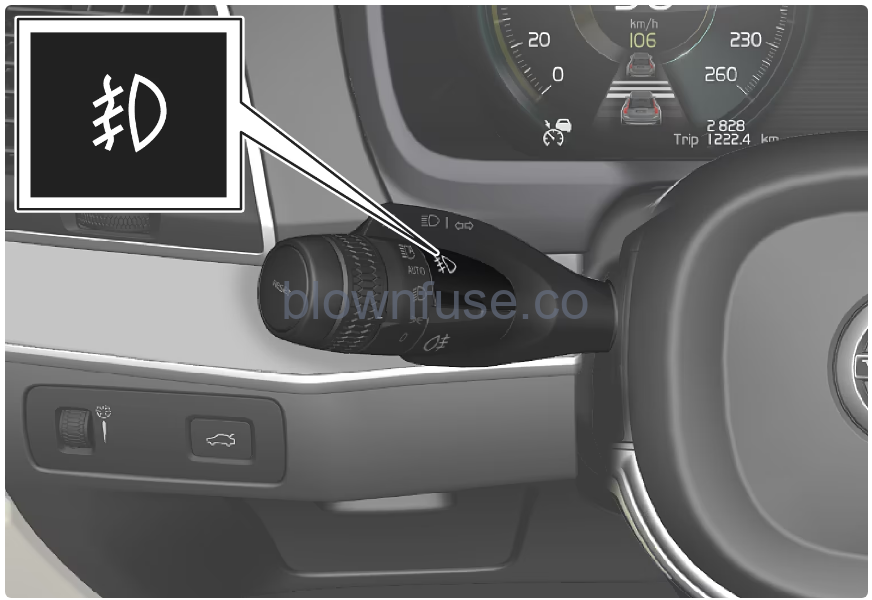
Button for front fog lamps.
The front fog lamps can only be switched on when the car’s electrical system is in ignition position II and the rotating ring on the stalk switch is in position AUTO, ![]() or
or ![]() .
.
Press the button to activate and deactivate. The ![]() symbol illuminates in the driver display when the front fog lamps are switched on.
symbol illuminates in the driver display when the front fog lamps are switched on.
The front fog lamps switch off automatically when the car is switched off or when the rotating ring on the stalk switch is set to the 0 position.
Note
Regulations on the use of fog lamps vary from country to country.
The front fog lamps can include the cornering lights function, which temporarily illuminates the area diagonally in front of the car in the direction the steering wheel is turned on a sharp bend, or in the direction shown by the direction indicators.The function is activated in weak daylight or darkness when the stalk switch’s rotating ring is in the AUTO or
Dipped beam
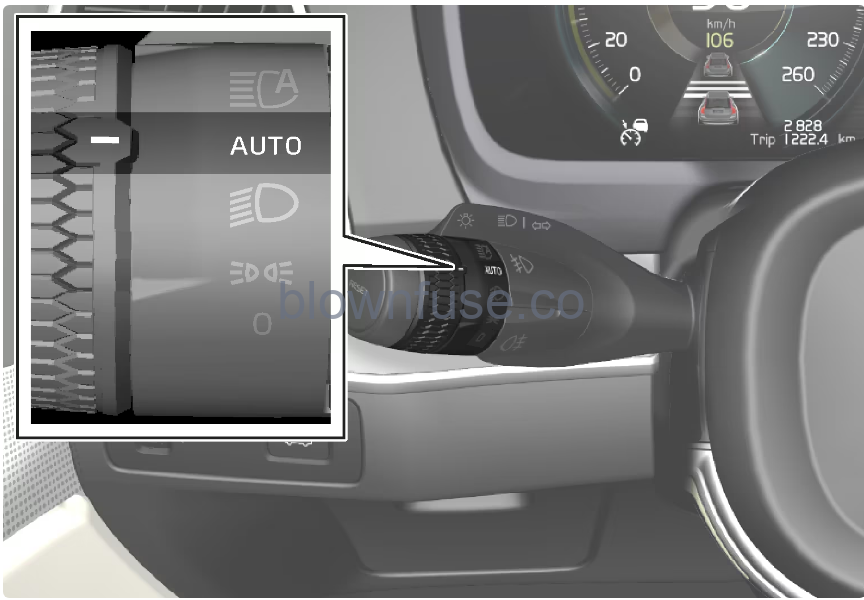
Stalk switch rotating ring in AUTO position.
With the stalk switch’s rotating ring in AUTO position, dipped beam is also activated automatically if:
- the front fog lamps are activated
- the rear fog lamp is activated
- the front and rear fog lamps are activated
With the stalk switch’s rotating ring in the ![]() position, dipped beam is always activated when the car’s electrical system is in ignition position II.
position, dipped beam is always activated when the car’s electrical system is in ignition position II.
Tunnel detection
The car detects when it is driven into a tunnel and switches from daytime running lights to dipped beam. Note that the rotating ring in the left-hand stalk switch must be in AUTO mode for tunnel detection to work.
Using main beam
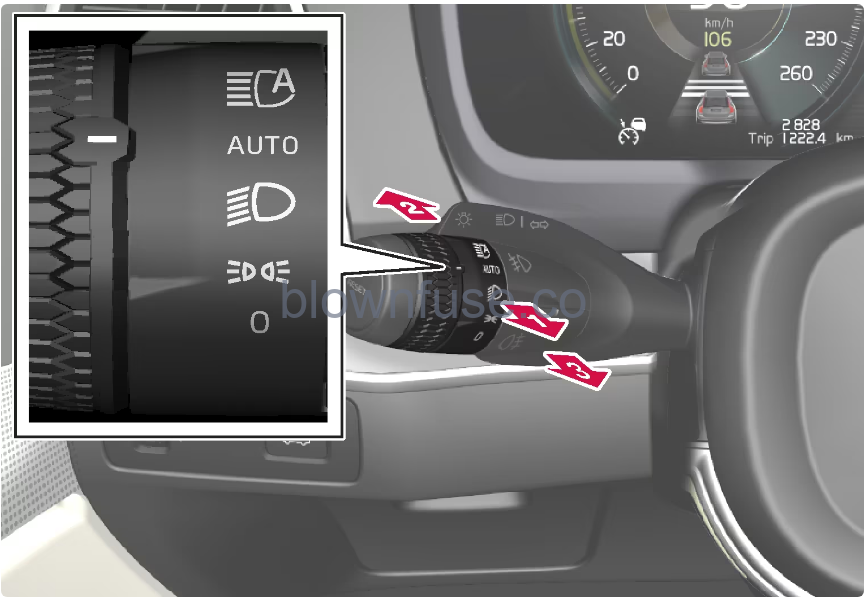
Steering wheel stalk switch with the rotating ring.
Main beam flash
| 1 | Move the stalk switch backward slightly to the main beam flash position. Main beam comes on until the stalk switch is released. |
Main beam
| 2 | The main beam can be activated when the steering wheel stalk switch’s rotating ring is in position AUTO or |
| 3 | Deactivate by moving the stalk switch backward. |
When the main beam has been activated, it can be deactivated by moving the stalk switch backward to either 1 position or 3 positions. When the main beam has been activated the
Using home-safe lighting
- To activate the function:
- Switch off the car.
- Move the left-hand stalk switch forward toward the instrument panel and release.
Get out of the car and lock the door. A symbol in the driver display is illuminated to indicate that the function is activated and outer lighting is switched on: Position lamps, headlamp beams, number plate lighting and lighting in outer handles.
The length of time that home safe lighting remains on can be set via the centre display.
Adapting the headlamp pattern from the headlamps
Emergency brake lights
Position lamps
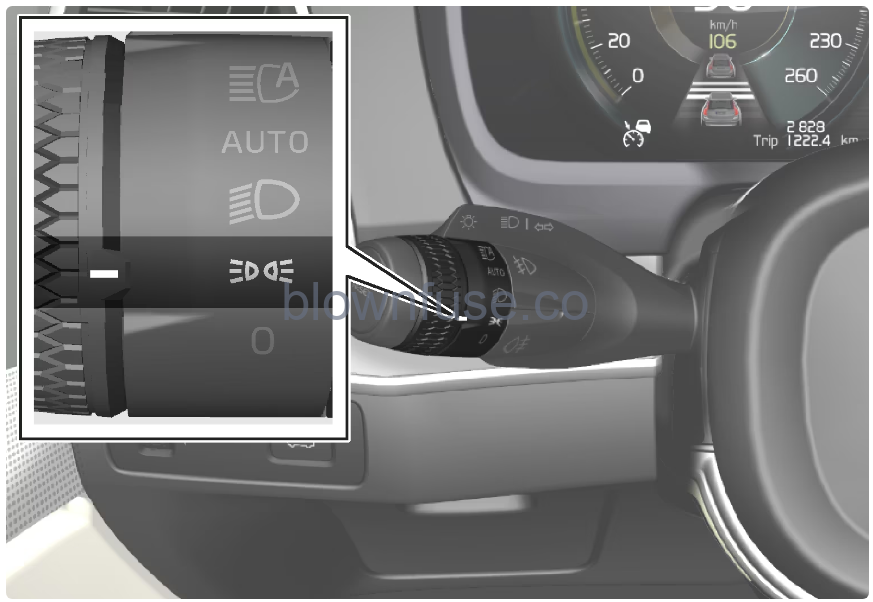
Stalk switch rotating ring in position lamps position.
Turn the rotating ring to the ![]() position – the position lamps are switched on (number plate lighting is switched on at the same time).
position – the position lamps are switched on (number plate lighting is switched on at the same time).
If the car’s electrical system is in ignition position II then the daytime running lights are switched on instead of the front position lamps. When the rotating ring is in this position, the rear position lamps are switched on regardless of the ignition position of the car’s electrical system.
If the car is stationary but running, the rotating ring can be moved to the position lamp ![]() position from another position to switch on only the position lamps instead of other lighting.
position from another position to switch on only the position lamps instead of other lighting.
When driving for more than 30 seconds at max. 10 km/h (approx. 6 mph), or if the speed exceeds 10 km/h (approx. 6 mph), the daytime running lights are switched on. The driver should turn to a position other than ![]() .
.
If the tailgate is opened when it is dark outside, the rear position lamps come on (if not already switched on) to warn road users approaching from behind. This takes place irrespective of the position of the rotating ring or the ignition position of the car’s electrical system.
Guidance light
Hazard warning flashers
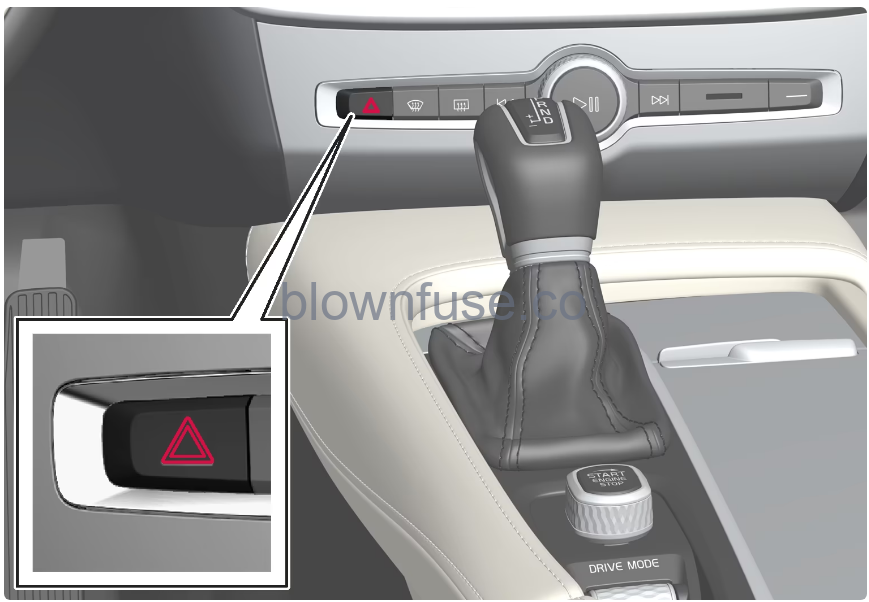
Button for hazard warning flashers. Press the button to activate the hazard warning flashers. The hazard warning flashers are automatically activated when the car brakes so powerfully that the emergency brake lights are activated and the speed is low. The hazard warning flashers start to flash after the emergency brake lights have stopped flashing and are then deactivated automatically when the car drives away again or are deactivated if the button is depressed.
The hazard warning flashers are automatically activated in the event of a collision.
Regulations for the use of hazard warning flashers may vary between countries.
Daytime running lights
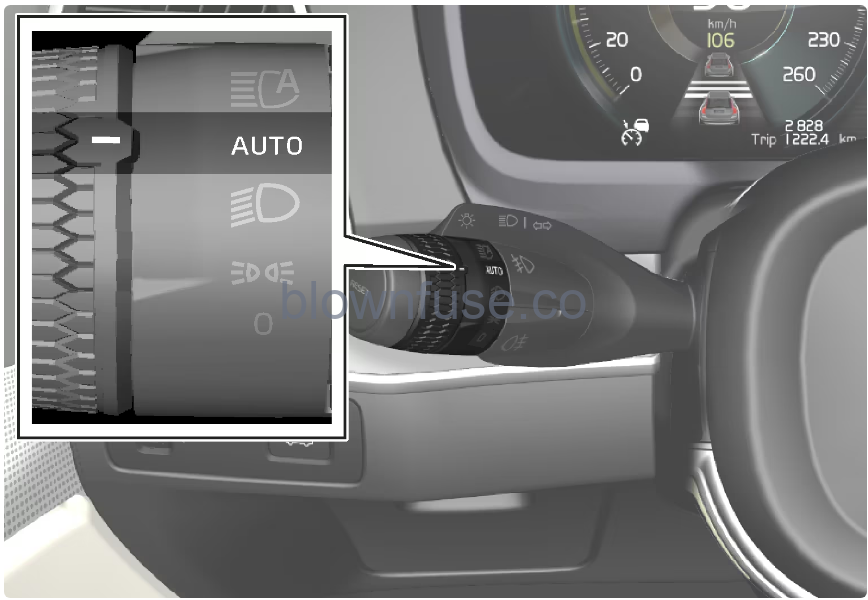
Stalk switch rotating ring in AUTO position. If the stalk switch rotating ring is in the AUTO position, the daytime running lights (DRL) are switched on when the car is driven in daylight. The car automatically changes lighting from daytime running light to dipped beam in weak daylight or darkness. Changing to dipped beam also takes place if the front fog lamp and/or rear fog lamp are activated.
This system help to save energy – it cannot determine in all situations when daylight is too weak or sufficiently strong, e.g. in mist and rain. The driver is always responsible for ensuring that the car is driven with the correct beam pattern for the traffic situation and in accordance with applicable traffic regulations.
Exterior lamp positions
The front lighting is only equipped with LED lamps.
Lamps, rear
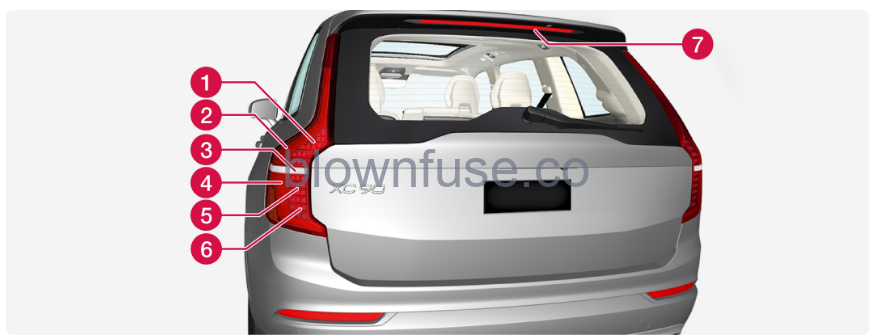
- Brake light (LED)
- Position lamps (LED)
- Reversing lamp
- Position lamps (LED)
- Direction indicator (LED)
- Fog lamp (LED)
- Brake light – central, high-level (LED)
Checking trailer lamps
Checking trailer lamps
Automatic checking
After a trailer is connected electrically, it is possible to check that the trailer lamps are working via automatic lamp activation. The function helps the driver check that the trailer lamps are working before starting off. The car must be switched off to perform the check. When a trailer is connected to the towbar, the Automatic Trailer Lamp Check message is shown in the driver display. Confirm the message by pressing the right-hand steering wheel keypad’s O button. The lamp check starts. Exit the car to check lamp functionality. All trailer lamps start to flash – then the lamps are switched on one at a time. Visually check that all lamps available on the trailer are operational. After a moment, all lamps on the trailer flash again. The check is complete.
Switching off automatic checkingThe automatic checking function can be switched off in the center display.
Press Settings in the top view.
Press .
Deselect Automatic Trailer Lamp Check.
If the automatic checking is switched off then it is possible to start the check manually.
Press Settings in the top view.
Press .
Select Manual Trailer Lamp Check.
The lamp check starts. Exit the car to check lamp functionality.
Rear fog lamp on the trailerWhen connecting the trailer, the rear fog lamp may not light up on the car. In such cases, the rear fog lamp function switches to the trailer. Upon activation of the rear fog lamp, check therefore that the trailer is equipped with a rear fog lamp to travel safely.
Symbols and messages in the driver displayIf one or more of the trailer’s direction indicators or brake light bulbs is broken, the driver display shows a symbol and a message. Other lights on the trailer must be checked manually by the driver before setting off.
| Symbol | Message |
|---|---|
 |
|
 |
|
If any lamp for the trailer’s direction indicators is broken, the driver display symbol for direction indicators will also flash more quickly than normal.

